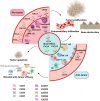Research progress of the chemokine/chemokine receptor axes in the oncobiology of multiple myeloma (MM)
- PMID: 38475811
- PMCID: PMC10935833
- DOI: 10.1186/s12964-024-01544-7
Research progress of the chemokine/chemokine receptor axes in the oncobiology of multiple myeloma (MM)
Abstract
Background: The incidence of multiple myeloma (MM), a type of blood cancer affecting monoclonal plasma cells, is rising. Although new drugs and therapies have improved patient outcomes, MM remains incurable. Recent studies have highlighted the crucial role of the chemokine network in MM's pathological mechanism. Gaining a better understanding of this network and creating an overview of chemokines in MM could aid in identifying potential biomarkers and developing new therapeutic strategies and targets.
Purpose: To summarize the complicated role of chemokines in MM, discuss their potential as biomarkers, and introduce several treatments based on chemokines.
Methods: Pubmed, Web of Science, ICTRP, and Clinical Trials were searched for articles and research related to chemokines. Publications published within the last 5 years are selected.
Results: Malignant cells can utilize chemokines, including CCL2, CCL3, CCL5, CXCL7, CXCL8, CXCL12, and CXCL13 to evade apoptosis triggered by immune cells or medication, escape from bone marrow and escalate bone lesions. Other chemokines, including CXCL4, CCL19, and CXCL10, may aid in recruiting immune cells, increasing their cytotoxicity against cancer cells, and inducing apoptosis of malignant cells.
Conclusion: Utilizing anti-tumor chemokines or blocking pro-tumor chemokines may provide new therapeutic strategies for managing MM. Inspired by developed CXCR4 antagonists, including plerixafor, ulocuplumab, and motixafortide, more small molecular antagonists or antibodies for pro-tumor chemokine ligands and their receptors can be developed and used in clinical practice. Along with inhibiting pro-tumor chemokines, studies suggest combining chemokines with chimeric antigen receptor (CAR)-T therapy is promising and efficient.
Keywords: CAR-T cell therapy; Chemokines; Multiple Myeloma (MM).
© 2024. The Author(s).
Conflict of interest statement
The authors declare no competing interests.
Figures
Similar articles
-
Chemokine signals are crucial for enhanced homing and differentiation of circulating osteoclast progenitor cells.Arthritis Res Ther. 2017 Jun 15;19(1):142. doi: 10.1186/s13075-017-1337-6. Arthritis Res Ther. 2017. PMID: 28619088 Free PMC article.
-
Advance in the role of chemokines/chemokine receptors in carcinogenesis: Focus on pancreatic cancer.Eur J Pharmacol. 2024 Mar 15;967:176357. doi: 10.1016/j.ejphar.2024.176357. Epub 2024 Feb 1. Eur J Pharmacol. 2024. PMID: 38309677 Review.
-
The contributory roles of the CXCL12/CXCR4/CXCR7 axis in normal and malignant hematopoiesis: A possible therapeutic target in hematologic malignancies.Eur J Pharmacol. 2022 Apr 5;920:174831. doi: 10.1016/j.ejphar.2022.174831. Epub 2022 Feb 17. Eur J Pharmacol. 2022. PMID: 35183534 Review.
-
Plerixafor: A chemokine receptor-4 antagonist for mobilization of hematopoietic stem cells for transplantation after high-dose chemotherapy for non-Hodgkin's lymphoma or multiple myeloma.Clin Ther. 2010 May;32(5):821-43. doi: 10.1016/j.clinthera.2010.05.007. Clin Ther. 2010. PMID: 20685493 Review.
-
Role of CXC group chemokines in lung cancer development and progression.J Thorac Dis. 2017 Apr;9(Suppl 3):S164-S171. doi: 10.21037/jtd.2017.03.61. J Thorac Dis. 2017. PMID: 28446981 Free PMC article.
Cited by
-
A novel CCL3-HMGB1 signaling axis regulating osteocyte RANKL expression in multiple myeloma.Haematologica. 2025 Apr 1;110(4):952-966. doi: 10.3324/haematol.2024.286484. Epub 2024 Nov 28. Haematologica. 2025. PMID: 39605211 Free PMC article.
-
Comprehensive analysis of the potential biological significance of CCL5 in pan-cancer prognosis and immunotherapy.Sci Rep. 2024 Sep 27;14(1):22138. doi: 10.1038/s41598-024-73251-9. Sci Rep. 2024. PMID: 39333254 Free PMC article.
-
Targets Selection for Precision Therapy of Relapsed/Refractory Multiple Myeloma: the Latest Advancements.Curr Treat Options Oncol. 2025 Feb;26(2):128-141. doi: 10.1007/s11864-025-01290-z. Epub 2025 Jan 31. Curr Treat Options Oncol. 2025. PMID: 39888475 Review.
-
CXCR Family and Hematologic Malignancies in the Bone Marrow Microenvironment.Biomolecules. 2025 May 13;15(5):716. doi: 10.3390/biom15050716. Biomolecules. 2025. PMID: 40427609 Free PMC article. Review.
-
Myeloma cell-derived CXCL7 facilitates proliferation of tumor cells and occurrence of osteolytic lesions through JAK/STAT3 pathway.Cell Death Dis. 2025 Feb 6;16(1):74. doi: 10.1038/s41419-025-07413-6. Cell Death Dis. 2025. PMID: 39915476 Free PMC article.
References
Publication types
MeSH terms
Substances
Grants and funding
- SHDC2020CR2070B/Shanghai Shenkang Hospital Development Center
- SHDC2020CR2070B/Shanghai Shenkang Hospital Development Center
- SHDC2020CR2070B/Shanghai Shenkang Hospital Development Center
- SHDC2020CR2070B/Shanghai Shenkang Hospital Development Center
- SHDC2020CR2070B/Shanghai Shenkang Hospital Development Center
LinkOut - more resources
Full Text Sources
Medical
Miscellaneous




